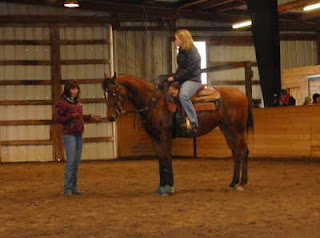Horse and Soul Parell USA Tour 2012..... An Gelding's Issues

Part One
Parelli's decision to work with the horse while the owner stood in a safe place made sense to me from the start. It appeared there were plenty of people in the audience who had noticed what I had seen but there were many more who didn't.
The reason she brought him to this event was to get help teaching him the games with the tarp and ball. She thought her problem was his fear of the items. Even his behavior in the arena she attributed to fear. The woman had been unable to keep this horse in his own space beside her just walking in the arena. She didn't realize her inability to keep him in a box next to her was really the root of her trouble with all of these things.
Once Linda Parelli took possession of the gelding it didn't take long for many of the those unknowning folks to
see the real reason behind the horse's behavior. It didn't take much for Linda Parelli to get this gelding into his own space beside her. He displayed some attitude about these changes but nothing particularly significant. It was at the tarp that the real show began.
When it came to walking up to the tarp, the horse acted much like he had with his owner just walking in the arena. His spoiled behavior included pushing into Linda Parelli as the horse charged away from the desired target. While that behavior alone was not enough to definitely rule out fear as the horse's motivation, other actions coupled with it made things crystal clear. It was more about the horse believing he didn't have to listen to his handler that caused his reaction to the task at hand than any kind of fear.
In the Parelli's terms, "You're not the boss of me," was the horse's motivation for not doing as he was asked. That phrasing was an easily understood aspect of the Parelli view of horsenality which was seen a number of times throughout the weekend. Each time it appeared more and more of the audience began to recognize the behavior for what it was.
This gelding displayed this attitude in movements and gestures that would have been obvious to someone looking for such things but not so obvious to those inexperienced in the body language of horses. During his bolt to avoid the tarp there was ear pinning and head wringing directed at Linda Parelli that clearly said he was flipping her off. Yet many horse owners tolerate such behavior thinking it is funny or cute without realizing its impact on every interaction between them.
Now with the behavior identified I wondered how many in this crowd would look at things differently. It was implied, if not outright spoken, this kind of statement from the horse was important and needed to be addressed. Linda Parelli certainly took action against it and she explained what she was doing but with the fast moving reactions of the horse the psychology behind it was not always explained, although her movements were.
The way the owner had first handled her horse in the arena suggested the woman was probably doing all she could just to avoid being run over when she worked with the horse near the tarp at home. With her skill level, self preservation was imperative considering the amount of gusto this horse used to avoid what he didn't choose to do. I doubt she had the time to look for such signs of his motivation during her attempts to teach him to navigate the tarp or the ball but, now, as she watched him with Linda Parelli she could see the behaviors that suggested he was testing Linda Parelli even if she didn't realize he had tested her at home.
I cannot tell you whether they said this horse was a right brain thinker or a left brain one even though it was explained. What course of action might be considered with this type of thinker was mentioned as well but without an understanding of the concept in the first place, I wouldn't even try to explain what I saw in those terms. Once the behavior was pointed out it seemed many in the audience were getting the idea this mindset was affecting the task at hand. To me, that was the part that was important. Just knowing you have a problem is essential if you ever hope to fix it.
Things said by the owner over the course of the demonstration suggested she was aware of these behaviors from this horse.. She had seen them during other tasks she did with him but she hadn't recognized the corollation between them and what she perceived as her current problem.
Even when she saw them actually within the current situation I'm not sure if she realized its importance to that interaction with the horse. Whether or not she understood how it might affect future challenges was not clear but at least the door was opened and Linda Parelli repeatedly emphasized any displays by the horse that suggested he was trying to hold onto his idea of being in charge.
To be continued........
Comparisons

















